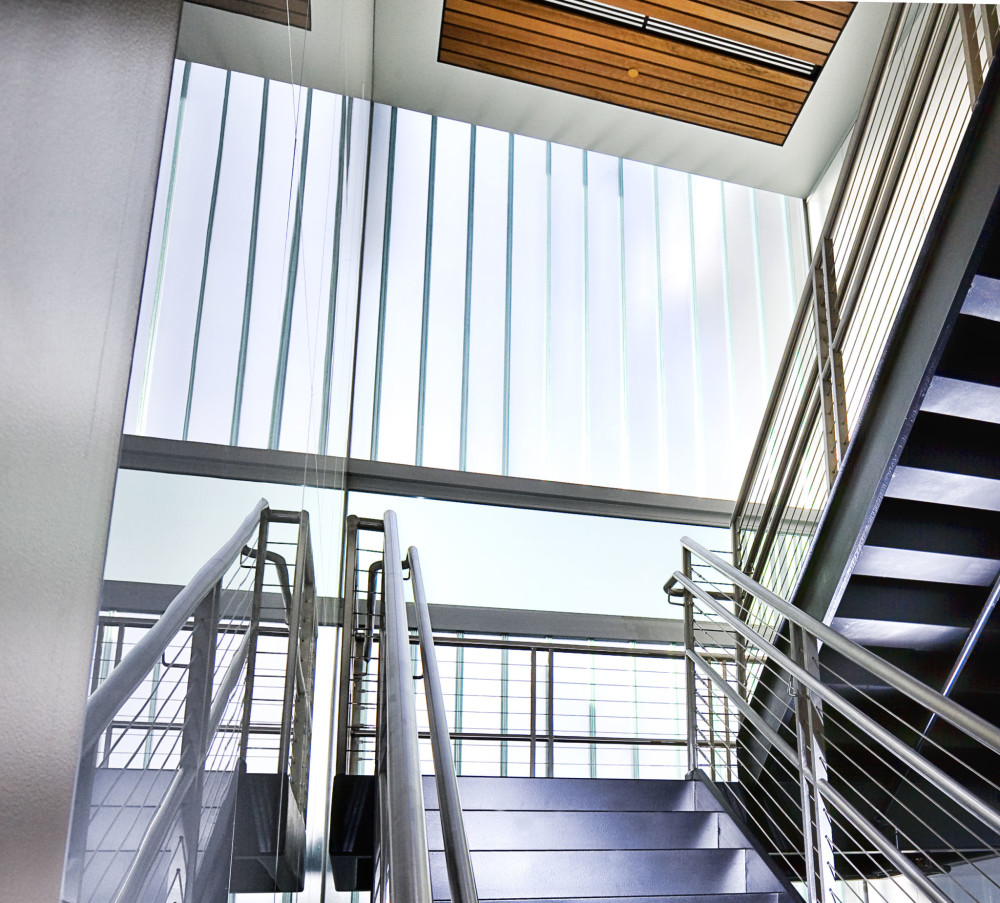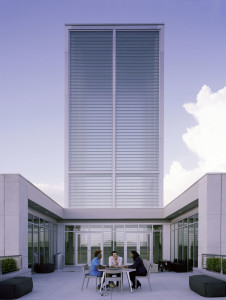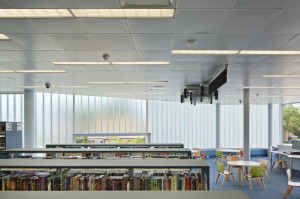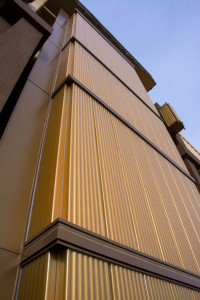Channel High Design: Part three
by Erik Missio | November 19, 2015 5:26 pm
 [1]
[1]Photos courtesy TGP
Specifying high-performance assemblies
by Jeff Razwick
As shown in Parts One[2] and Two[3] of this article series, design professionals can use channel glass’ slender, versatile shape to transfer daylight into interiors with style, create object architecture, or add ‘movement’ to a building. For those new to the material, a common question is whether these design benefits extend to buildings with stringent hurricane, sound, and thermal insulation requirements.
Thanks to the material’s distinctive shape and composition, the answer can be ‘yes,’ but it depends on the product. Manufacturers can apply coatings, polycarbonate laminates, films, and other surface treatments to channel glass, creating a glazed system that provides a superior level of performance without sacrificing important design goals. As these high-performance products differ from the standard channel glass options discussed in the first two parts of this series, the following article will provide an overview of today’s advanced channel glass systems, starting with hurricane-rated channel glass.
Hurricane-rated channel glass
For design professionals interested in specifying channel glass in coastal regions, there are two types of hurricane-rated systems available to protect building occupants from high winds and windborne debris when a storm strikes—large and small missile impact-resistant channel glass.
Large-missile impact-resistant channel glass
Large-missile impact-resistant channel glass systems provide the highest level of hurricane protection available in North America. The advanced systems incorporate channel glass with a polycarbonate laminate bonded to its inside surface to meet Miami-Dade County and state of Florida requirements—the current hurricane-code benchmarks. They are tested and approved to the following standards:
- Miami-Dade County and Florida state’s requirements for the large-missile impact test (per Florida Building Code [FBC] testing application standard (TAS) 201-94; cyclic wind pressure loading per FBC TAS 203-94; and FBC TAS 202-94, which is specific to the air and water portions of the testing);
- small-missile impact test (ASTM 1996-06, Standard Specification for Performance of Exterior Windows, Curtain Walls, Doors, and Storm Shutters Impacted by Windborne Debris in Hurricanes); and
- cyclic loading (ASTM 1886-06, Standard Test Method for Performance of Exterior Windows, Curtain Walls, Doors, and Storm Shutters Impacted by Missile(s) and Exposed to Cyclic Pressure Differentials) at 100 percent of the design pressure (DP), as defined in ASTM 1996-06.
Design professionals can specify large-missile impact-resistant channel glass for hurricane- or impact-rated applications. In either situation, the glass channels are approved for heights up to a maximum of 3 m (10 ft), and can be installed in vertical configurations only. No wind anchors are needed at this height. Where desirable to create extended expanses of glazing, the framing and narrow glass channels can be stacked over floor slabs. The channel glass segments can also be raked, making it possible for the panels to change elevation gradually across their width to create visual interest in a vertical plane.
Since large-missile impact-resistant channel glass systems are tested for large and small missile resistance and cyclic loading, they can protect against high winds and windborne debris without supplemental protective devices like films or shutters. This helps preserve the sleek, contemporary lines desired by many architects.
 [4]
[4]Small-missile impact-resistant channel glass
Small missile impact-resistant channel glass systems use heat strengthened and filmed cast-glass channels and an extruded perimeter frame that have been tested and approved in accordance with the small missile impact test. Since the system does not pass the large-missile test, it is limited to a minimum of 9 m (30 ft) or higher above ground level. When installed at the appropriate height, the cast-glass channels provide great design freedom in storm-prone regions.
For example, the cast-glass channels can be installed in vertical and horizontal orientations, and can extend up to 3.7 m (148 in.) high in vertical applications and 4.1 m (162 in.) wide in horizontal applications. The vertically glazed channels can be raked or stepped, and can incorporate stacked joints to create dramatic glazed façades that protect against storm damage.
This flexibility proved advantageous when Sottile & Sottile; Lord, Aech & Sargent; and Dawson Architects were designing a glass tower to sit atop the Savannah College of Art Design (SCAD) Museum of Art’s 19th-centruy brick remains. By specifying small-missile impact-resistant channel glass in a horizontal, dual-glazed configuration, they were able to create a 26.2 m (86-ft) tall tower that punctuates the Savannah skyline by day and is backlit at night.
While small-missile impact-resistant channel glass opens up room for design creativity in hurricane regions, one important caveat is it cannot be installed in curved and serpentine orientations, as can standard channel glass systems.
 [5]
[5]Photo © Eduard Huber/Arch Photo Inc.
Channel glass insulation
As described in Part One[6], channel glass’ configuration helps combat excessive heat gain or loss to improve occupant comfort. The individual glass segments can be mounted in an overlapping fashion to create an insulating dead-air-filled space and thermal gap. This arrangement results in a solar heat-gain coefficient (SHGC) of approximately 0.70 and a U-value of 0.49.
While functional, the channel glass cavity is also a tool for design teams to improve energy efficiency. By specifying insulation within the channel glass’ air-filled space, design professionals can further reduce heat loss and minimize solar heat gain. One of the most effective materials for this is aerogel insulation.
Aerogel is a highly porous, non-hazardous silica that is made of 95 percent air. It is, therefore, translucent and exceptionally lightweight. In channel glass systems, it is encased in 16-mm (0.6-in.) or 25-mm (0.9-in.) polycarbonate panels that are held inside the channel glass cavity with snap-on centering clips. This configuration helps protect the aerogel from exposure to moisture, dirt, and other debris. When placed inside channel glass’ air-filled gap, it can help reduce the SHGC to 0.31 and the U-value to 0.19 with marginal impacts on light transmission. As an added benefit, aerogel insulation can help minimize unwanted noise, resulting in a sound transmission class (STC) of 44.
Aerogel can be installed in dual-glazed channel glass systems in vertical, horizontal, or curved/serpentine configurations.
Functional coatings
Channel glass is also available with functional coatings to meet specific project demands. Popular options include low-emissivity (low-e), solar, and high-performance color coatings.
Low-e coating
Channel glass with a low-e coating can increase the energy efficiency of the system by improving the glass’ U-value. It accomplishes this by reflecting infrared light (i.e. heat energy) back into the building during the cold months, and reflecting or absorbing energy from the outside to reduce the amount of excess heat coming into the building during the summer. As a result, uninsulated channel glass with a low-e coating can reduce the U-value to 0.45.
While a low-E coating can be applied to all available channel glass textures, it cannot be sandblasted as this will strip the coating off, eliminating the performance benefit.
 [7]
[7]Solar coating
Channel glass with a solar coating helps reduce the total solar radiation transmittance into the building, resulting in an approximate SHGC value of 0.38. It is translucent with a slight bronze tint, and can be applied to all available channel glass textures. As with low-e coatings, it cannot be sandblasted.
Durable color coating
Channel glass with a high-performance color coating does not require tempering, and is bonded to the glass with high adhesion strength to resist chipping and fading. It is available in a wide array of opaque and metallic colors with varying translucency to match the building’s color scheme, and can be applied to standard and low-iron channel glass options in all available textures. For added protection and opacity, design teams can specify an optional flood coating.
High-performance color coatings are ideal for channel glass walls, façades, or partitions where long-lasting, colorfast beauty is central to the project. This was the case for the Hollywood Casino in Columbus, Ohio, where the design intent was to capture the golden age of Hollywood from the outside of the building in. To create this aesthetic, Marnell Architects specified low-iron, wave-shaped channel glass with a translucent, metallic gold, high-performance coating. The metallic coating and wave-shaped texture of the channel glass intensify color and light to form optical variations for casino visitors, and create an exterior that sparkles gold both day and night.
Conclusion
While channel glass first became popular for its ability to diffuse natural light into buildings, it continues to gain traction for its multifaceted design and performance benefits. It is one of the few modern glazing materials that can stand up to Mother Nature, transfer daylight, and preserve a building’s original design intent. To learn more about using channel glass to its full potential in building design, one can contact a channel glass manufacturer or supplier for the latest information, code updates, and design support.
 [8]Jeff Razwick is the president of Technical Glass Products (TGP), a supplier of fire-rated glass and framing systems, and other specialty architectural glazing. He writes frequently about the design and specification of glazing for institutional and commercial buildings. Razwick is a past-chair of the Glass Association of North America’s (GANA) Fire-Rated Glazing Council (FRGC). He can be contacted via e-mail at jeffr@fireglass.com[9].
[8]Jeff Razwick is the president of Technical Glass Products (TGP), a supplier of fire-rated glass and framing systems, and other specialty architectural glazing. He writes frequently about the design and specification of glazing for institutional and commercial buildings. Razwick is a past-chair of the Glass Association of North America’s (GANA) Fire-Rated Glazing Council (FRGC). He can be contacted via e-mail at jeffr@fireglass.com[9].
- [Image]: http://www.constructionspecifier.com/wp-content/uploads/2015/11/Large-Missile-Hurricane.jpg
- Parts One: http://www.constructionspecifier.com/channel-high-design
- Two: http://www.constructionspecifier.com/channel-high-design-part-two/
- [Image]: http://www.constructionspecifier.com/wp-content/uploads/2015/11/Small-Missile-Hurricane-SCAD.jpg
- [Image]: http://www.constructionspecifier.com/wp-content/uploads/2015/11/Channel-Glass-Insulation.jpg
- Part One: http://www.constructionspecifier.com/channel-high-design
- [Image]: http://www.constructionspecifier.com/wp-content/uploads/2015/11/Hollywood-Casino.jpg
- [Image]: http://www.constructionspecifier.com/wp-content/uploads/2015/11/Jeff-Razwick-Bio-2015.jpg
- jeffr@fireglass.com: mailto:jeffr@fireglass.com
Source URL: https://www.constructionspecifier.com/channel-high-design-part-three/